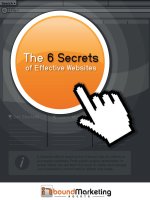6 secrets of effective websites
Bạn đang xem bản rút gọn của tài liệu. Xem và tải ngay bản đầy đủ của tài liệu tại đây (935.13 KB, 59 trang )
1
Search
Get Started! Learn More! Make it work!
A Detailed eBook sharing the 6 Secret tips for effective,
successful websites. From search engine optimization to
social media, you will learn the tools to create and manage
your business’s content and to attract new leads.
The 6 Secrets
of Effective Websites
2
Table of Contents
Why Inbound Marketing?
Secret 1: Home Page Design
Secret 2: SEO
Secret 3: Blogging
Secret 4: Social Media
Secret 5: Landing Pages
Secret 6: Lead Nurturing
Take-Away
Contact Us!
Citations
2
9
14
24
32
41
48
56
57
58
3
Why Inbound Marketing?
Over 75% of adults in the United States use the
Internet
1
. Experts estimate that 8 new people come
online each second
2
. At least 10 billion Google
searches are performed each month
3
and one third
of the population spends at least 3 hours online
each day
4
. Highly effective websites know the internet
has changed the way people make purchasing de-
cisions. Maintaining an active brand presence online
is essential. Inbound Marketing lets companies get
found by the people that matter.
FACT
THE INTERNET HAS FUNDAMENTALLY
CHANGED THE WAY PEOPLE FIND,
DISCOVER & SHARE
Source: 120 Marketing Stats, Page 5
FACEBOOK TWITTER
4
61%
of global Internet users
research products
ONLINE.
Did You Know?
Source: 120 Marketing Stats, Pg. 26
FACEBOOK TWITTER
5
It’s a fact that consumers worldwide are rapidly
adopting major search engines as the top way to
begin making purchase decisions. The internet is
beating out newspapers and magazines and quickly
becoming the top way that people perform research.
Can your customers find your company online?
Inbound Marketing shifts your focus from finding
prospects to being found by people who want to
be your customers.
Best of all? Inbound marketing works, and it’s cheap.
It’s a fact that outbound marketing just doesn’t work
like it used to. The average consumer is bombarded
with between 3,500 and 5,000 marketing messages
each day
5
. People have become experts at tuning
out traditional modes of advertising.
search engine optimiz
FACEBOOK TWITTER
6
Source: 120 Marketing Stats, page 10
Blogs, social media and email marketing will take
your marketing budget a lot further than traditional
interruption advertising campaigns. The average
inbound lead now costs significantly less than an
outbound lead
6
.
7
Inbound marketing costs
61% LESS
per lead than traditional outbound marketing.
OUTBOUND
Average cost per lead =
$346
INBOUND
Average cost per lead =
$135
What Are You Waiting For?
FACEBOOK TWITTER
8
Blogs, social media and most importantly search
engine optimization will increase your reach and
provide you with the most value for your marketing
budget. Inbound marketing isn’t a fleeting fad or a one
hit wonder. You’re simply adjusting your approach
to meet the changing needs of modern consumers.
The world is changing, and inbound marketing has
become the smartest way to get your company’s
message out.
Inbound Marketing Works
FACEBOOK TWITTER
9
Source: 120 Marketing Stats, Page 22
THE BOTTOM LINE
Go inbound or go home.
In this eBook, you’ll learn the 6 secrets of effective
websites who know how to be found by the leads
that matter. From social media to SEO, you’ll learn
the tricks to building relationships with customers
that count. Just having a website isn’t enough,
so listen closely and commit to taking your company
to the next level.
Jump into action with a commitment to building an
online presence so you no longer have to worry
about finding business. Let your future business
leads find you!
FACEBOOK TWITTER
10
HOMEPAGE DESIGN
FACEBOOK TWITTER
11
SECRET #1: Homepage Design
Your website homepage will be the first time the majority of
visitors to your company website meet your company. Getting
the design right is crucial for giving a professional first
impression. Pack as much information as possible into this
homepage. Hubspot’s 12 crucial components of effective
home page design will yield the best possible results.
FACEBOOK TWITTER
12
12
Critical Elements
Every Homepage Must Have
Headline Success Indicators
Sub-headline Navigation
Benefits Supporting Image
Primary CTAs Content Offer
Features Resources
Customer Proof Secondary CTAs
Click here for more information
13
Getting Started with
Building an Impressive Homepage
1: Write on-page content that will pack a big
punch. The goal is to incorporate as much information
into the descriptions of your company as possible.
Within paragraphs, website visitors should know
what your company does, why it matters and how it
can help them.
2: Make it visual. Display your company logo in a
prominent location and include visual representations
of your business, especially if your product or service
is a little complex.
On the Go To Meeting virtual business meeting website, visitors are offered a
clear image that depicts a way that Go To Meeting can be used.
FACEBOOK TWITTER
14
3: Offer a variety of ways to connect. In addition
to links to the company blog, calls to action and
more information about your products and services,
allow your customers to take the connections off
the website with visible links to your social media
profiles.
4: Don’t be modest. Your homepage is a perfect
place to boldly display most impressive customer
testimonials and awards your company has received.
List the logos of any business associations to
which you belong. The Bottom Line is your company
homepage is a first-impression for many of your
customers, so make sure you put your most pro-
fessional face forward.
FACEBOOK TWITTER
15
SEARCH ENGINE
OPTIMIZATION
FACEBOOK TWITTER
16
SECRET #2: SEO
If search engines can’t find your website,
your prospects can’t either. While the major-
ity of modern consumers are using the web
to find the best deals and products, the
overwhelming majority of your customers
aren’t going to look too hard. Highly effec-
tive websites know that Search Engine
Optimization (SEO) is the very best step
towards developing a visible online presence.
If your company doesn’t take the time to
achieve and maintain a high ranking in
major search engines, you could be losing
loads of business to your competitors.
SEARCH
ENGINE
OPTIMIZATION
FACEBOOK TWITTER
17
Did You Know?
We already mentioned that consumers worldwide
perform a staggering
10 BILLION GOOGLE SEARCHES
each month. Beyond that,
44%
of consumers
begin their pur chase by performing research on
a major sea rch engine ?
That’s around
4.4 billion
searches each month from
people who just might need your company’s product.
Smart websites know that in order to get traffic
from qualified leads, they need to be visible and
in the
TOP PAGE
of search results.
FACEBOOK TWITTER
18
75%
of users
never scroll past
the first page of
search results.
That’s right, 75% of search engine users never scroll
past the first page of search results
8
. 60% of organic
traffic goes to the top 3 rankings for search results
9
. If
your website comes in 4th or on the 2nd page of searches,
you might as well not be online at all. The solution isn’t
to resort to “pay per click” online advertising. 70% of all
web traffic is organic
10
, meaning it comes from people who
are using search engines to find their own answers and
solutions. The average consumer looks increasingly like
someone who is smart, savvy and makes purchase decisions
by performing their own research. The trick to placing
your website where it can be found by people who matter
is adopting SEO.
Source: 120 marketing stats, page 33
FACEBOOK TWITTER
19
FACT
GOOGLE IS THE NEW YELLOW PAGES
It’s a fact that Google is the new yellow pages, and
top search ranking is more effective than paid ad-
vertising. In order to achieve and maintain a high
ranking in major search engines, you need to
adopt keyword analysis. Keep an eye on industry-
relevant keywords and produce quality website
content that incorporates these keywords. The
most effective websites take advantage of page
descriptions, alt text, meta tags and meta descriptions
to use top keywords. Think of keywords as the best
way to introduce your website to search engines.
The more information and relevant keywords you
provide to search engines, the more likely they are
to introduce you to qualified leads.
FACEBOOK TWITTER
20
Figure out your starting point by summarizing your
company in a single search term, whether you are
a Dentist in Denver or an Esthetician in Edmonton.
Plug this phrase into a major search engine, and
see what happens. If you aren’t listed on the top
page of search results, you are losing at least
75% of your prospects to competitors.
FACEBOOK TWITTER
21
Getting Started
with On-Page SEO:
SEO best practices require using keywords everywhere you can
while still maintaining smart, valuable content with a great flow.
Learn to maximize your keyword density by identifying the prime
real estate for keywords on each web page.
1: URL. Your page URL should accurately describe
the content and include the primary keyword.
Check out this example from Inbound Marketing
Agent’s top-performing blog content, You Can’t Eat
a Facebook Like:
The primary keyword, “Facebook Like” is a clear
member of the URL, adding an extra punch of SEO.
2: Page Title. If SEO was an introduction, page
titles would be the name. Pick a title and give your
content a little extra SEO mileage by including an
H1 tag, defined as an in-text introduction to your
content. Through the use of an H1 tag, we’ve been
able to include the primary keyword twice.
FACEBOOK TWITTER
22
3: Alt text includes keywords. Alt Text is SEO for
your on-page images. Write a short sentence that
briefly describes the content with the primary keyword:
4: Keyword Density. Track your keyword density in
the on-page text, aiming for a target of about 2.5-
3.5%. Producing content within the range of this
target density will maximize the visibility to search
engines without sacrificing quality. Use secondary
longtail keywords, defined as key phrases that are
at least 3 words in length, in addition to the primary
keyword for more targeted SEO.
We post content through the
Hubspot module, which allows
us to simply and easily tag
images with a short, pithy
description centered around the
primary keyword
FACEBOOK TWITTER
23
5: Meta description. Use your secondary keyword
and a third keyword. Write a sentence or two that
accurately describe the content without exactly
replicating the title. This is a perfect place for including
longtail keywords.
This is a sneak peek into the meta keywords and
meta description aspect of the Hubspot module.
You can see that we’ve clearly differentiated the
meta description by including a longtail keyword, in
this case “value of Facebook like.”
FACEBOOK TWITTER
24
FACT
THE MORE KEYWORD-RICH CONTENT
YOU GENERATE, THE MORE SEARCH
ENGINES WILL FIND (AND LOVE) YOU.
The bottom line is that your search ranking
counts big, so optimizing isn’t optional.
FACEBOOK TWITTER
25
BLOGGING
FACEBOOK TWITTERFACEBOOK TWITTER









